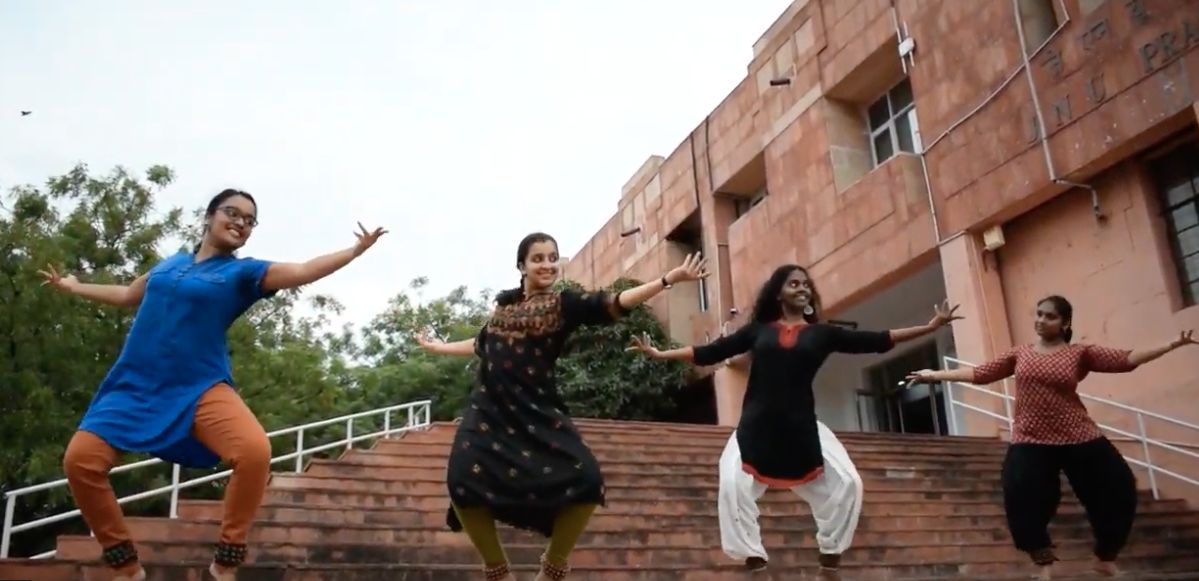Have you ever tried to imagine a classical dance performance without the accompanying fanfare? No music, costumes, special lighting or stuffy auditorium setting?
A group of young artists – Swathi Gangadharan, Priyanka Kali and Aishwarya Kali – has been taking their art to the streets, performing and recording themselves dancing at regular places, dressed in their usual track pants and kurtas. While Gangadharan is the principal dancer, the other two shoot and edit the videos. Apart from brightening up otherwise pedestrian lives, their project has enabled them reclaim the city’s spaces as their own.
Also read: A Feminist Guide to Delhi
From the stage to the streets
Bharatnatyam in the Wild (BitW) started when two of the group’s members recorded Swathi Ganagadharan and Tirna Sengupta’s performance in their college classroom, to send it to Priyanka Kali and Aishwarya Kali’s sister. They said that the video looked surprisingly beautiful even without music or costumes.
Excited about finding a new way to explore the city and their dance, they began documenting their nritta (dance) in their college’s corridors, the library, then the basketball courts, their homes and then graduated to the railway station, main roads and even inside metro compartments.
The dancers say that the pieces they perform don’t “have a dramatic component” because they want people to focus on the act of them performing in public, not the nitty-gritty of the dance. “We usually avoid doing complex choreographies that have storylines because we want the focus to be on the story that the female dancing body tells in relation to the public space she inhabits and the claim (or lack thereof) she has to them,” said Swathi Gangadharan.
Bharatnatyam, as a dance form, has never been accessible to the masses – it went from being confined to temples to fancy auditoriums. But BitW is nudging this historical precedent by taking the dance form to every nook and cranny of the city.
“The only people who can go to these auditoriums or learn these dance forms are those with the luxury of extra income, which is unfortunately a tiny part of our country. But when we perform suddenly in public spaces, we have no control over who has access to this performance. Non-elite audiences encounter the art form outside its usual enclosed spaces, usually for the first time,” added Gangadharan.
However, it has not been an easy exercise because people stare, ignore and often reprimand them for downgrading the classical art form. Recalling one such incident, Priyanka kali said, “After we filmed a video outside the INA metro station, we had an interesting encounter with someone who asked us to perform for bhagwaan (god), instead of performing like this, i.e. for fame.”
Embedded social messages
The group has also started using their idea to convey socio-political messages by tailoring their performances to the locations they choose. For instance, when Jawaharlal Nehru University declared the administrative block a no-protest zone, these women danced their way around the ban.
“We used that space to dance instead, as a larger protest against the tyranny of institutionalised spaces,” said Aishwarya Kali. In one of the initial scenes, the camera beautifully captures Gangadharan’s movement as she confidently climbs up the stairs of the building.
The group has also pushed the envelope by performing a dance based on the Hindu holy trinity in front of a mosque. “To see Bharatanatyam through this narrow lens is to take away the power and range it contains to tell all kinds of stories, not just Hindu myths. People from all walks of life can, and should, find meaning in its expansive dance-drama universe,” said Priyanka Kali.
They’ve also inverted their own practice by recording a video where a member, dressed up for a Bharatnatyam performance, goes about her daily life. This was another attempt to blur the boundaries between the artistic and the routine.
Reclaiming public space
Women’s bodies have always been a source of great societal anxiety – and women dancing in public spaces is no exception. But these women are managing to take their city back for themselves, despite the shame and censure thrown at them.
“Dancing is a confident flaunting on the body. And doing so in a public space, where women have been forever marginalised, is doubly subversive…Dancing is the kind of fun, spontaneous activity that says to the world that we are not only unashamed of our bodies, we revel in our mastery over them!” said Gangadharan.
Going forward, the group plans to experiment with camerawork – the unacknowledged audience in this whole project. They hope to put up a full-scale performance with saree, makeup and all, on the streets sometime soon.
Featured image credit: Facebook

